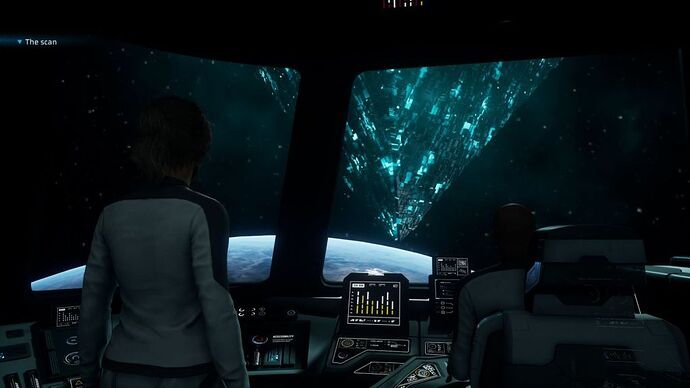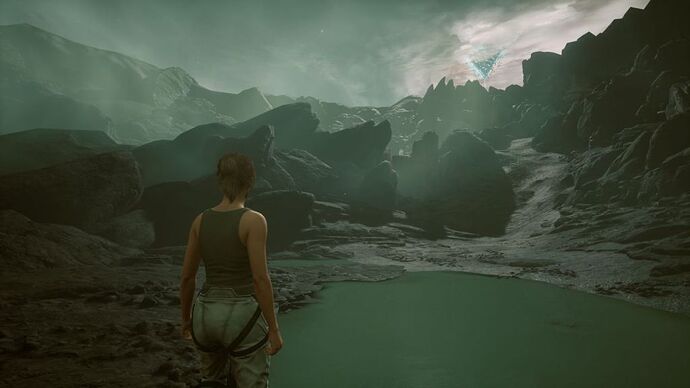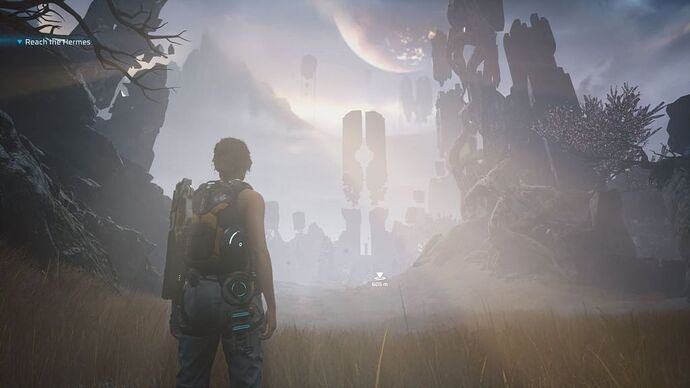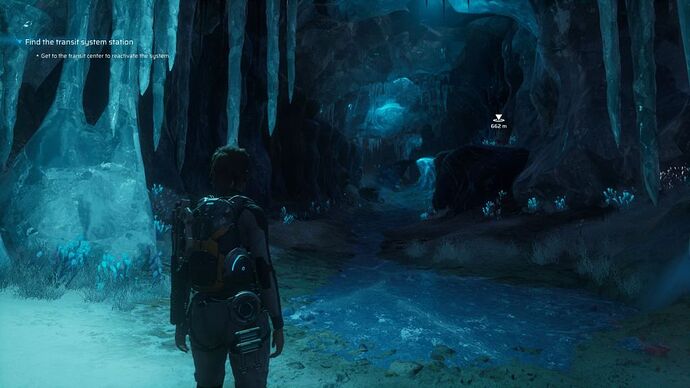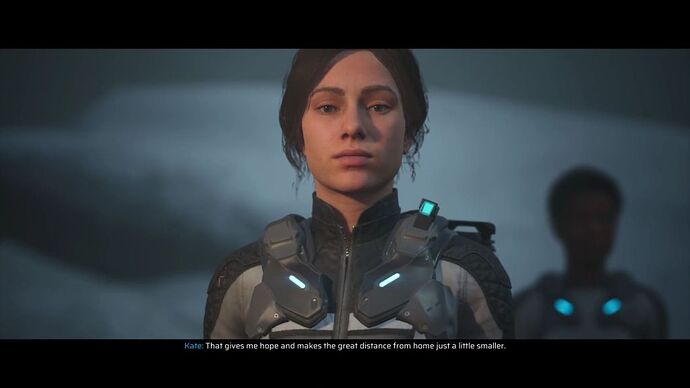Originally published at: Review | Scars Above - XboxEra
When my partner first saw me play Scars Above, she basically called it a mixture of Ninja Theory’s cult classic Hellblade: Senua’s Sacrifice and Denis Villeneuve’s intriguing sci-fi flick Arrival. And well, she definitely was on point there – throw in a little bit of Returnal’s action-packed gameplay and dark visuals, and we’re certainly close to nailing the recipe for this game. But while on the surface the similarities seem evident, Mad Head Games’ first foray into “big” cinematic third person games comes with many interesting ideas as well.
Barging into the AA space like…
This game falls into the camp of the cinematic third person games “punching up”. Inevitably unable to compete with colossi such as The Last Of Us 2, made by a gargantuan team of over 2000 people in total and a ludicrous budget to boot, games like the first A Plague Tale, Hellblade or even Returnal offer surprisingly impressive graphics but end up cutting some corners by padding out the experience with more backtracking or replaying through already seen before sequences. This isn’t any different for Scars Above, but it’s not as noticeable as one may think. Mad Head Games made dozens of relatively simple indie games and this is by far their biggest project yet, and it’s a surprising one in many ways.
Story-wise, plenty of sci-fi and horror classics of any medium can be taken as references. Not just the already mentioned Arrival, Returnal and some of the psychological elements of Hellblade, but also Electronic Arts’ recently revived Dead Space franchise seem to have been to some levels of inspiration for this game’s premise. The player takes the role of Kate Ward, a highly trained scientist who’s been sent, alongside three other crew members, on a mission to explore a recently arrived giant alien artifact that’s orbiting around Earth. In the months it’s been there, there has been no contact, attack or anything, and this small group of scientists has been specifically prepared for whatever they may find in this purely scientific research mission. Those who know their sci-fi horror tropes already know what’s up: the ship is suddenly pulled in and crashes, with our protagonist stranded and alone needing to find the rest of the crew and figure out what’s up in this increasingly bizarre place.
Into the unknown
For obvious reasons I’ll not dive too deep into the story and lore in itself. Visually, there’s a lot of brutalist alien architecture with a lot of acute angles, triangle-shaped objects (including the giant alien artifact itself) with a lot of darkness to boot, quite reminiscent of Returnal in its visual style. This alien microcosmos effectively contains various biomes in itself, from lush (if desolate) vegetation, caverns, alien labs and more. Thematically, the game dives into an increasingly interesting and esoteric plot and lore, though the main revelations and twists are things I saw sci-fi and horror media tackle before. I still think the execution is commendable, even though the few talking characters in the game are about as generic and forgettable as they get, with very little in terms of backstory or outstanding personalities to boot.
So how does Scars Above play? If you are watching our video review, you may have seen glimpses of combat and exploration already, and I’m glad to report it’s got a pretty satisfying gameplay loop. Movement isn’t insanely fast, but certainly the pace is higher and there’s more room to manouver than in your average Resident Evil or Dead Space, and the combat is action-based, even if not excessively frantic in practice. The player unlocks several elemental weapons that can be combined in a vast array of ways, even using the environment for further advantage. Wet enemies will be more susceptible to the shock-based weapons, cold biome enemies are hard to freeze but are usually vulnerable to fire, patches of ice on water can be broken to let enemies fall into frozen traps, with the risk of ending there ourselves. With a shooting that is pretty snappy and fast, though sometimes the optional auto-aim can make hitting certain spots a bit rough, the combat loop feels satisfying enough, and fighting is extremely prevalent especially in the first half of the game.
World of hurt
As the biomes become increasingly dark and twisted as we go towards the inside of the alien artifact, the once increasingly difficult and engaging combat gives more and more room to exploration and worldbuilding. Chapter 4, just over the halfway point of the game, features almost entirely just puzzles to solve, lore to embrace, dialogues to get through. This is when the artifact’s mystery becomes more and more clear, revealing some rather devastating truth that we’ll have to process in the next chapters. I can see the second half of the game become an object of controversy for this reason – the story takes front and center, with sometimes entire half an hour sequences with practically no combat other than a few occasional foes, in stark contrast with the almost non-stop barrage of action of the first couple hours.
Speaking of enemies, this alien formation gives us all kinds of familiar shapes in its alien design, with anything from yeti-esque creatures, spiders, flying enemies spouting venom and more – for this being a foreign place, the creatures are surprisingly close to mutated versions of real-life animals, with even the aliens being rather humanoid in their look. In terms of gameplay, this means that most of the enemy tropes are well covered: fast-crawling small insects, flying foes, “tanky” giants that charge the player, worm-inspired creatures that can pop up all across the place, with even killer plants and turrets making some appearances. Perhaps the enemy design could have been a bit more unique, but the fun elemental combat and the interactive scenarios make sure these encounters flow pretty well, with each enemy having a few ways to “cheese” them more effectively to shorten the battle drastically.
Dark Scars
If you followed coverage of the game before its release, such as our very own Jesse’s preview back from December, you may remember comparisons with souslike games such as, well, Dark Souls. Don’t be alarmed about the difficulty, the game is fairly challenging at times but always fair, with the elemental combat always offering some relatively easy way out. It’s more about the structure of the levels, which are fairly linear, yet sometimes offer alternate pathways, shortcuts to unlock and so on while progressing towards the main objective. Wandering off the beaten path can reward the player with XP boosts, upgrades and even new abilities, so definitely keep an eye on alternate routes. In key locations, people also find altars to interact with – these function as save points, and when they’re activated all enemies respawn, all ammo resources and healthpacks regenerate and so on. But unlike From Software’s classics, death is not a huge punishment, as the player does not have to recover any lost resources when dying – in fact, all progress obtained during a failed run still counts towards objectives, with bosses killed, doors opened and such staying the way they are.
The game is rather generous with its updates as well, as by exploring a fair bit I managed to abundantly unlock and upgrade everything not tied to story-related progression long before the end credits rolled, even though the fixed location of XP upgrades means you can’t just grind to get there quicker. Various cool tools are unlocked during play as well, such as being able to spray enemies in flammable fuel, a bubble that slows down the time for enemies but not the players, all the way down to health and ammo replenishments. By the end, the player becomes quite the killing machine, with several weapons upgraded to hell and back, a large ammo and health pack reserve and tons of tools. While I had some trouble in some earlier encounters, most fights near the end took me a single try on normal difficulty, with only the final boss taking me like 3 or 4. Despite this apparent divide, before the last boss the game brings the player back to three prior biomes to clear some combat arenas and puzzles, featuring some of the more challenging combat encounters in the whole game. This was probably one of the weakest sections of the entire games as I would have rather explored yet another biome instead of revisiting old locations to do slightly harder fights. But overall the difficulty is generally fair and balanced, though a few shortcomings come up here and there.
Scarring experience
Namely, some puzzles. While most of them are rather straight-forward, others require some rather obtuse thought processes. It doesn’t help that in two separate occasions, a key object failed to load, so I only managed to progress when I reloaded the last save – but not before scratching my head immensely for seemingly getting wrecked by a pretty easy puzzle. Likewise, I had trouble in a few combat scenarios because the enemies would straight up pin me into a corner, with their large hitbox not allowing me to escape anymore, or some odd level geometry that made me fall through the walkable ice and die to hypothermia. The latter can be an annoyance in some parts, because chapter 3 features a snowy biome with occasional snowstorms, in which the player will have to ignite single-use plants to get some heat. Nothing too complicated, except a couple times when this has to be juggled with some intense combat encounters, in which it’s easy to lose sight of the short fuse towards freezing to death.
As a relatively low budget production, some corners have been cut here and there and it shows. While the general presentation of the graphics is great, the characters and their animations don’t always look too great, with seemingly large levels featuring a lot of invisible walls and obstacles where there shouldn’t be any. I noticed some occasionally questionable command input, with attempts at healing or other quick commands seemingly not working in certain conditions, alongside some rare framerate drops when an area is particularly big and full of particles or when a combat encounter becomes overly chaotic. Also, given its cross-gen nature with PlayStation 4 and Xbox One versions also available, expect a lot of hidden loading screens as the protagonist crawls through tight spaces Nothing too troublesome, with only the disappearing items I mentioned earlier that made me lose more time than I really would have wanted.
In space, no one can… too obvious, eh?
Even so, I enjoyed my almost 9 hours of gameplay on normal difficulty from start to the end credits. The last hours take the plot and lore into some rather exciting locations, with some dark themes and visuals involved, as even the main character’s mental health is questioned more than once. Scars Above is a good-looking cinematic third person action game with engaging combat, a cool if not particularly original plot narrated via some rather average characters in excellent and exciting locations. As an “AA” release, it cuts some corners compared to the behemoths of the genre to make ends meet, but the end credits roll on a satisfying note before the game’s formula and ideas could become boring or repetitive. Mad Head Games’ first foray into the cinematic third person games doesn’t try to reinvent the formula, yet offers an engaging, memorable and atmospheric adventure that I can wholeheartedly recommend to any fan of the genre who’s able to appreciate the game’s relatively limited scope.
![Review | Scars Above [4K]](https://forum.xboxera.com/uploads/default/original/3X/d/b/db1817641d3c43c1e85a88be39fed048dc6ed8f0.jpeg)
